Certain circumstances cause farmers to raise lambs on a bottle. Either the mother dies during labor and delivery, does not have sufficient milk, or a ewe may reject her lamb. In this article, we’ll go over how to raise healthy bottle lambs and discuss what good lamb milk replacers should provide nutritionally. We’ll also cover how often to bottle feed lambs at every stage of development, the amount of milk they should get at different ages. We include the tips and tools to create a bottle-feeding schedule that doesn’t keep you up at all hours of the night.
Deciding to Keep a Bottle Lamb
Once you realize a lamb will have to be fed by bottle, you must decide whether or not to keep it. Farmers with large-scale operations without the time to bottle feed sometimes give away these lambs, or even sell them. Bottle lambs make good pets and often go to kids starting out in 4H whose parents want them to have the experience of raising a lamb.
Those with small operations will probably decide that keeping the lamb is a good financial decision. A lamb that has been nursing from its dam for a number of days might have difficulty getting it to accept a rubber nipple. In such cases, you should continue trying to teach the lamb to accept the rubber nipple.
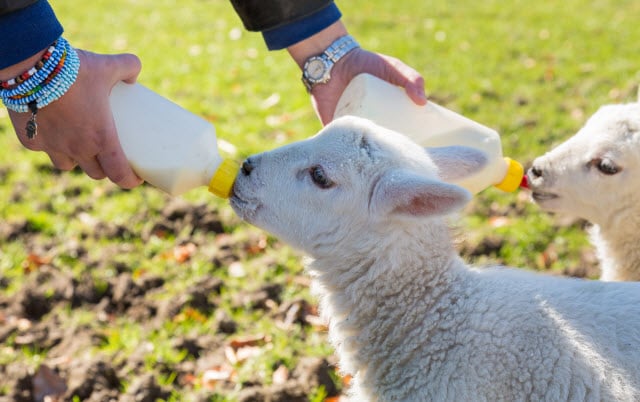
I’ve had really good luck getting lambs onto the Premier 1 Lamb bottle with a Pritchard teat (Amazon link).
Bottles vs Bucket
Once the lamb is accustomed to rubber nipples, you may decide to move it on to a bucket with nipples placed around the bottom. You can get these nipples as a special kind of unit. It should include a ballcock, to avoid leaks.
Teaching the lamb to drink from nipples at the bottom of the contraption accustoms them to feeding themselves, like from their mother’s nipples. Also, it will make it easier for you when you need to put them back in the barn.
If you have an indoor pen for a lamb (like in your kitchen), be prepared for messes. Lambs urinate quite often. Make sure you have cleaning equipment, like a simple mop and bucket, on hand. This will be necessary even if you use absorbent mats.
My advice is to keep the lamb outside as much as you can – a good heat lamp and dry bedding and most lambs who are eating will do just fine.
If you have a single set of bottle lambs, a bucket probably isn’t necessary – you’ll be feeding them by bottle 3 times a day most of the time until weaning, which is manageable (morning, afternoon, before bed). For large operations with a lot of bottle lambs, definitely train them on a bucket.
Nutritional Requirements for Lamb Milk Replacer
If your lamb was never fed by its dam, that means it has never had colostrum. The first 24 hours after a lamb is born is critical for them to get this special fluid. Colostrum comes from the mother’s mammary glands and is full of important antibodies and minerals. It always appears before true milk is produced.
The lamb’s intestinal tract is only able to absorb the crucial antibodies found in colostrum during the first 24 hours of the lamb’s life. Sooner is better. It’s preferred to give the colostrum to the bottle lamb during the first 12 hours of its life.
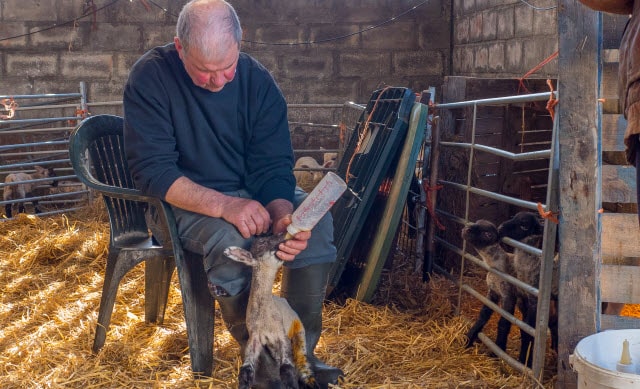
If you can get frozen ewe colostrum, that is ideal. However, frozen cow colostrum should provide enough antibodies for your lamb to be healthy. Lambs should be kept in a dry, warm, and enclosed area.
My advice is that every year you have lambs on your farm you take a bit of extra colostrum from your ewes and freeze it in an ice cube tray. Once frozen, store the cubes in a plastic bag so they’re ready in case you ever need them.
Another good idea is to buy some lamb colostrum replacer before lambing season begins. Milk & Co. makes a good one (Amazon link).
Make Sure Lambs Get Proper Nutrients
If you do set up a milk bar or bucket for your lambs, you should never put extremely young lambs together with older lambs in the same pen. Very young lambs might not be getting enough milk replacer, as the older lambs will shove them out of the way and drink most of it themselves. If you do keep them with older lambs, just make sure you supplement the youngest ones with a bottle a few times a day.
When lambs are put in the nursery, they should be given shots of certain supplements:
- Vitamin ADE
- Iron-dextran
- Combiotic
If you have a lamb that needs to have a colostrum replacement because it never received it from its mother, make sure that you administer it. Some experts recommend using a Pritchard Teat and a high-quality feeding bottle to do this. You should make sure the lamb gets colostrum during the first 18 hours of its life. After that, you can move on to warm milk or milk replacer.
Choose the Appropriate Milk Replacer
When budgeting for the cost of bottle lambs, one bag of the appropriate milk replacer is about $30. The size and appetite of your lamb will vary, but I’d budget for a minimum of 35 pounds of milk replacer per lamb to get them weaned. Manna Pro makes a good one (Amazon link), and so does Sav-a-Lamb (Amazon link).
When choosing a milk replacer for your lambs, you must carefully review the composition of the replacer. Many commercially produced lamb milk replacers are available, and while many are marketed as multi-species milk replacers, I encourage you to get lamb-specific milk replacers for your sheep. They’re specifically formulated for lambs.
What to Look For in a Lamb Milk Replacer
Below are some tips to keep in mind when it comes to lamb milk replacers:
- Look for milk replacers that have 30 percent fat minimum. Lambs must have enough fat. There should be 25 percent milk protein in the milk replacer.
- You can add fat to milk replacers if that is necessary. This can be done with butterfat or white grease. Never use any kind of vegetable oil.
- Dilute the milk replacer with water so that is a minimum of 20 percent dry matter. There should be two pounds of milk replacer for each gallon of water.
- Before you feed lambs, make sure to properly mix the replacer. Stay away from milk replacers that won’t remain in suspension. Once you have mixed the milk replacer powder into warm water, immediately cool it down to approximately 33 degrees Fahrenheit. Doing this will help to cut out the issue of ingredient separation that can happen in storage.
- To prevent scours and other types of digestive disorders, ensure that there is a high level of antibiotics in the milk replacer.
How to Feed Milk Replacement to Lambs
You don’t want the lamb to gulp the milk too quickly, as this may lead to digestive upsets. A nipple feeder pail can help with this. Always keep the valves and nipples thoroughly clean. If you don’t, your lamb could end up with a bacterial infection.
The pails must be kept extremely clean, even as clean as a dish you would use in your kitchen.
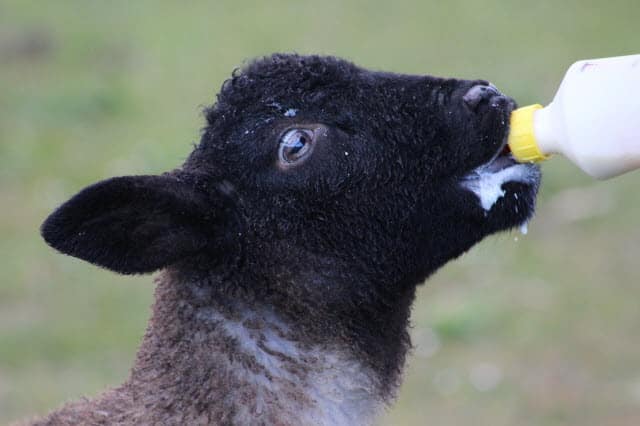
Cold milk may be better than warm milk. Research indicates lambs may do better with cold milk (milk between 35 and 40 degrees Fahrenheit) than warm milk. This is because cold milk is not as likely to sour.
At each nursing session, a lamb will drink just a small amount of the milk replacer. Keeping the milk cold (at the temperatures we mentioned) will reduce the likelihood that it will begin to go bad.
We always mixed and kept a few bottles in the fridge, warming them in a pot with water on the stove just before feeding the lambs.
Bottle Feeding Lambs at Different Stages of Development
Lambs that you are going to bottle feed will need to learn how to suck from a bottle. It may sound a bit odd, but some sheep farmers will do this using pop bottles. You can put a nipple that has been made in a size to fit the lamb’s mouth on the end of the bottle.
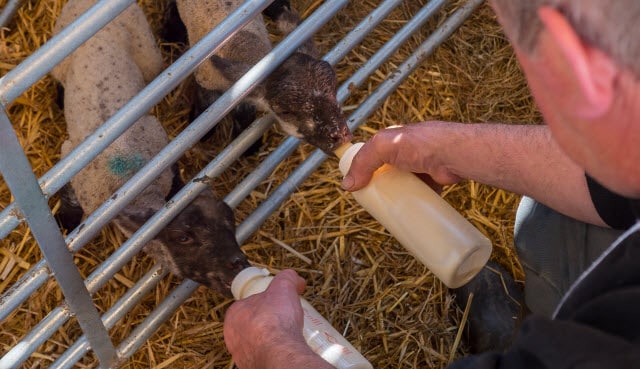
When the lamb is about one week old, it will probably start being interested in nibbing at foods such as cracked corn and hay. Make sure the animal has small amounts of this kind of food accessible in a creep environment (a pen that lambs can access but mature sheep cannot).
Weaning
Remember that a ewe will begin to naturally wean lambs when they are a month to six weeks old. When you bottle feed lambs, aim to wean them around the same time. You may be surprised to hear this, but bottle fed lambs can often go back to the barn as young as a week or two weeks old. In mild weather, your lambs may never come inside and may be in the barn from birth.
You should aim to get them weaned by 45-50 days through gradual reduction of how many milk feedings you give them (while keeping the other food and water we mentioned available).
Some farmers will tell you to wean them after a month, but I think the extra fat content from the milk for a few more weeks helps to ensure the lambs growth isn’t stunted significantly.
Tips and Tools for Creating a Lamb Bottle Feeding Schedule
It’s quite easy to get enough sleep when feeding a bottle lamb, as there is no need to feed a lamb at night most of the time.
During the first few days, you’ll probably want to get up and make sure the lamb gets food every 6 hours at a minimum, but within a week or two you can stretch this timing out so that you do morning, daytime, and evening bottles.
With very young lambs a trick to tell if they’re getting sufficient food is to stick your finger into their mouth. If it’s warm, the lamb is ok … cold, and they need more calories.
At most stages, if the lamb is properly fed, it will be fine if you leave it overnight without feeding. You will find that the baby animal is just extra hungry and more eager to eat in the morning.
The lamb milk replacer you choose will have a feeding schedule on the back of the bag. Follow it, and time your feedings to fit your schedule so that you can minimize the impact on your day-to-day life.
Lambs Need Warmth and Social Interaction
As herd animals, lambs need social interaction. When they cannot have that with others of their species because of circumstances, humans can fill that gap. During the time that you bottle feed the lamb, interact with them and let them sit with you (or on you) when you go about your day.
Spend time cuddling with the lamb. The warmth of your body will help provide it with the warmth that it needs and will make it feel safe, contributing to health and happiness. Talk to the lamb when you spend time with it. It will find the sound of your voice soothing and reassuring.
The Long-Term Impact of Bottle Feeding Lambs
Ewe lambs raised as bottle lambs tend to remain social and friendly for the rest of their lives. They’ll often come right over to you in the field or barn for a scratch.
Ram lambs are the same way, but once they mature and their testosterone kicks in this friendliness can often make them aggressive. Keep this in mind if you’re considering keeping a ram raised by a bottle.
Raising Healthy Bottle Lambs is a Lot of Work (and fun)
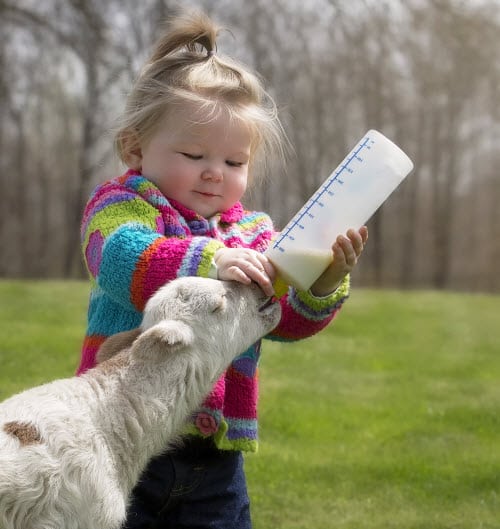
Bottle feeding a lamb is easy once you’re out of the woods during the first week, and it’s usually no more than a 2-month commitment, but for those two months you’ll be tied to your farm in a way that you may not normally be.
In my experience, raising a bottle lamb is a commitment that is manageable because it always happens at a time of year when I expect to stay close to the farm to be on call for lambing and to do more frequent monitoring of the health of my flock to ensure my new lamb crop is thriving.
Bottle lambs won’t grow to their potential the way lambs raised on their mom’s milk will, but you’ll end up with a friendly lamb that you’ll bond with, and raising bottle lambs can be a great learning experience for young children.


I have twin lambs that were found in a paddock next door, so I’m bottle feeding them and I will keep them as pets as I have 8.5 Acres with good food for them. I found your information very useful and helpful thanks
Glad this helped, Mark! Good luck with your lambs.